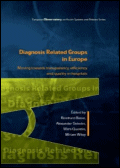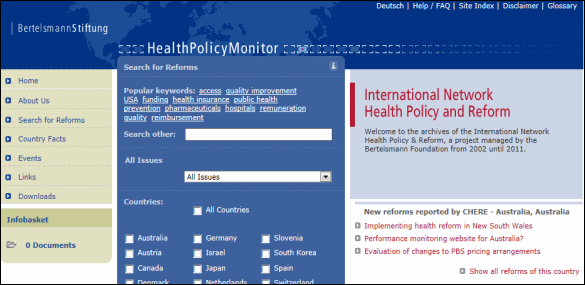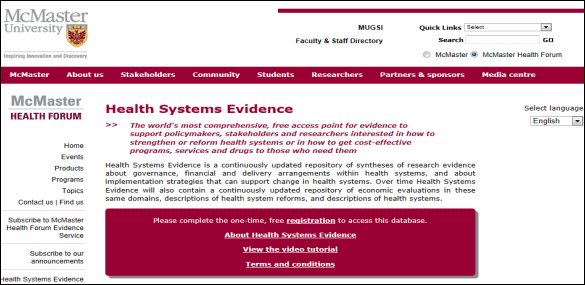SELECTED FOR YOU... JANUARY 2012:
 books of the month
books of the month
 site of the month
site of the month
 working papers
working papers
All the Selected for you
BOOKS OF THE MONTH
Diagnosis-related groups in Europe : moving towards transparency, efficiency and quality in hospitals.
Les groupes homogènes de malades en Europe : évoluer vers la transparence, l'efficience et la qualité à l'hôpital.
Busse R., Geissler A., Quentin W., Wiley M.
Maidenhead : Open University Press - Mc Graw Hill : 2011 : 20 p. + 458 p.
At the EuroDRG final conference, which is held in Berlin, 17 November 2011, the main results of the EuroDRG research project will be presented and discussed with policy-makers, researchers and stakeholders from Europe and beyond. Diagnosis Related Group (DRG) systems were introduced in Europe to increase the transparency of services provided by hospitals and to incentivise greater efficiency in the use of resources invested in acute hospitals. In many countries, these systems were also designed to contribute to improving - or at least protecting – the quality of care. After more than a decade of experience with using DRGs in Europe, the EuroDRG research project considered whether the extensive use of DRGs has contributed towards achieving these objectives. During this conference, a new Observatory publication Diagnosis-Related Groups in Europe - Moving towards transparency, efficiency and quality in hospitals will be officially launched. The book is intended to contribute to the emergence of a `common language' that will facilitate communication between researchers and policy-makers interested in improving the functioning and resourcing of the acute hospital sector (Résumé de l'éditeur).
Governing public hospital : Reform strategies and the movement towards institutional autonomy.
Gouvernance des hôpitaux publics : stratégies de réforme et mouvement vers une autonomie institutionnelle.
Saltman R.B., Duran A., Dubois H.F.W
Copenhague : OMS Bureau régional de l'Europe : 2011 : 16 p. + 278 p.
Governance of public hospitals in Europe is changing. Individual hospitals have been given varying degrees of semi-autonomy within the public sector and empowered to make key strategic, financial, and clinical decisions themselves. This study explores the major developments and their implications for national and European health policy. The study focuses on hospital-level decision-making and draws together both theoretical and practical evidence. It includes an in-depth assessment of eight different country models of semi-autonomy, in the Czech Republic, England, Estonia, Israel, the Netherlands, Norway, Portugal and Spain. The evidence that emerges throws light on the shifting relationships between public-sector decision-making and hospital-level organizational behaviour and will be of real and practical value to those working with this increasingly important and complex mix of approaches (Résumé de l'éditeur).
Financing long-term care in Europe : Institutions, markets and models.
Financement des soins de longue durée en Europe : Institutions, marchés et modèles.
Costa-Font, Courbage C.
New York : Palgrave Macmillan : 2011 : 13 p. + 341 p.
The ageing of the European population brings new financial risks that call for state, market and societal responses. In 2011, the first baby-boom generation is turning 65, and forecasts predict that the size of the old-age population in need of long-term care will double in the next 50 years in Europe. However, how different countries are responding to the challenge of financing long-term care is still a question open to further examination, including the role of market development, changing intergenerational contracts and especially the constraints of state intervention. Growing long-term care needs in several European countries as well as the reshaping of traditional modes of care-giving further increase the pressure for sustainable funding of more comprehensive long-term care systems. This book examines different forms of partnership and the potential cooperation of state, market and societal stakeholders. It not only offers a full understanding of the institutional responses and mechanisms in place for financing old age but also provides a deep analysis of both the demand and supply factors underpinning the development of financial instruments to cover long-term care needs in Europe (Résumé de l'éditeur).
SITES OF THE MONTH
Health Policy Monitor
www.hpm.org
Health Systems Evidence
www.healthsystemsevidence.org/open-search.aspx
WORKING PAPERS
Hospital
Can Governments Do It Better? Merger Mania and Hospital Outcomes in the English NHS. 

Les gouvernements peuvent-ils faire mieux ? La manie des fusions et ses conséquences pour les hôpitaux anglais
Gaynor M., Laudicella M., Propper C.
Cambridge : NBER : 2011/11 : 36 p.
The literature on mergers between private hospitals suggests that such mergers often produce little benefit. Despite this, the UK government has pursued an active policy of hospital merger. These mergers are initiated by a regulator, acting on behalf of the public, and justified on the grounds that merger will improve outcomes. We examine whether this promise is met. We exploit the fact that between 1997 and 2006 in England around half the short term general hospitals were involved in a merger, but that politics means that selection for a merger may be random with respect to future performance. We examine the impact of mergers on a large set of outcomes including financial performance, productivity, waiting times and clinical quality and find little evidence that mergers achieved gains other than a reduction in activity. In addition, mergers reduce the scope for competition between hospitals.
Evaluating Hospital Efficiency Adjusting for Quality Indicators: an Application to Portuguese NHS Hospitals. 

Evaluation de l'efficience des hôpitaux ajustée aux indicateurs de qualité : une application aux hôpitaux publics portugais.
Almeida A., Fique J.P.
Porto : Universidade do Porto, Faculdade de Economia do Porto ; 2011/10.
The objective of this paper is to develop a methodology to incorporate measures of hospital quality in efficiency analysis, applied to Portuguese NHS hospitals, in order to assess whether there is a trade-off between efficiency and quality in Portuguese hospitals. We develop and compare two methodologies to compute DEA technical efficiency scores adjusted for output quality, for a sample of Portuguese NHS hospitals in 2009. When DEA efficiency scores are adjusted for output quality, the decision making units that lie on the technical efficiency frontier remain largely unaltered, even if a great weight is given to quality indicators over quantity indicators of output. Nevertheless, we find that outside of the frontier adjusting for quality does have an impact in efficiency scores.We conclude that the empirical evidence is not sufficient to identify a clear trade-off between efficiency and quality in the hospitals under review, implying the possibility that efficiency gains may achieved without a significant sacrifice of service quality. Nevertheless, there is enough evidence to conclude that analyzing hospital efficiency without consideration of differences in quality of service will generate biased results. When perceived quality is brought to the analysis, the gap between efficient and inefficient units tends to widen.
Social Health Inequalities
Disparities in Social Assistance Receipt between Immigrants and Natives in Sweden. 

Disparités dans les prestations d'aide sociale entre les immigrants et les autochtones en Suède.
Gustafsson B.
Bonn : IZA : 2011/11 : 39 p.
Social assistance receipt among immigrants in relation to receipt among natives in Sweden is investigated. A background of how the system is constructed is provided, statistical information reported, the literature surveyed and key results interpreted. Most out-payment for social assistance in Sweden refers to foreign born persons although the category makes up 14 percent of the population. While some part of the high costs can be attributed to needs to maintaining recent refugees, this is not the entire story. Immigrants tend to assimilate out of social assistance receipt. However, receipt continues to be higher than among in several characteristics identical natives many years after immigration among immigrants from not rich countries. The elevated probabilities of social assistance receipt among immigrants from not rich countries are mainly due to failures of integrating into the labor market at the destination.
Long-Term Effects of Early Childhood Care and Education. 

Les effets sur le long terme des soins et de l'éducation précoce des enfants.
Ruhm C., Waldfogel J.
Bonn : IZA : 2011/11 : 25 p.
This paper critically reviews what we know about the long-term effects of parental leave and early childhood education programs. We find only limited evidence that expansions of parental leave durations improved long-run educational or labor market outcomes of the children whose parents were affected by them, perhaps because benefits are hard to measure or confined to sub-groups, or because leave entitlements were sufficiently long, even before recent extensions, to yield most potential benefits. By contrast, expansions of early education generally yield benefits at school entry, adolescence, and for adults, particularly for disadvantaged children; however the gains may be less pronounced when high quality subsidized child care was available prior to the program expansion or when subsidies increased the use of low quality care.
Social Security
The Effects of the Recent Economic Crisis on Social Protection and Labour Market Arrangements across Socio-Economic Groups 

Les effets de la récente crise économique sur la protection sociale et sur le marché du travail dans les différents groupes socio-économiques.
Basso G., Dolls M., Eichhorst W. et al.
Bonn : IZA : 2011/10 : 23 p.
The Great Recession did not only affect European countries to a varying extent, its impact on national labour markets and on specific socio-economic groups in those markets also varied greatly. Institutional arrangements such as employment protection, unemployment insurance benefits and minimum income support, working time flexibility and wage setting played a crucial role in determining to what extent the economic crisis led to higher unemployment, wage cuts or income losses and rising poverty. As the crisis gained momentum, the action of automatic stabilisation mechanisms built into the national tax-benefit and social protection systems was accompanied by heterogeneous sets of discretionary policy measures. While these factors can explain cross-country variation in labour market developments, they also lead to an unequal distribution of economic risks associated with the crisis across socioeconomic groups. The present paper aims to investigate and assess to what extent the financial and economic crisis that hit the global economy in 2008-2009 impacted these labour market developments and to what extent different socio-economic groups were affected.
Primary health care
Estimating and predicting the distribution of the number of visits to the medical doctor. 

Estimer et prévoir la distribution du nombre de visites chez le médecin.
Dai J., Zucchini W., Sperlich S.
Rochester : Social Science Electronic Publishing : 2011 : 17 p.
In many countries the demand for health care services is of increasing importance. Especially in the industrialized world with a changing demographic structure social insurances and politics face real challenges. Reliable predictors of those demand functions will therefore become invaluable tools. This article proposes a prediction method for the distribution of the number of visits to the medical doctor for a determined population, given a sample that is not necessarily taken from that population. It uses the estimated conditional sample distribution, and it can be applied for forecast scenarios. The methods are illustrated along data from Sidney. The introduced methodology can be applied as well to any other prediction problem of discrete distributions in real, future or any fictitious population. It is therefore also an excellent tool for future predictions, scenarios and policy evaluation.
Health care system
Prices and Choices in the Swiss Health Care Insurance Market. 

Prix et choix au sein du marché de l'assurance maladie en Suisse.
Ortiz Y.
Gerzensee : Study Center Gerzensee.: 2011/11 : 30 p.
This paper describes three different extensive data sets on the Swiss market for basic health care insurance—a homogeneous product by construction. First, it provides descriptive statistics on market prices for period 2004 - 2010. Second, it presents aggregated data on health plan choices made by Swiss residents in the same period. Third, it describes and analyzes an extensive survey executed in 2009 which documents health care plan and insurer choices of enrollees as well as their switching behavior. Price data reveal an increase of the mean price level and substantial and persistent price level differences across regions. This working paper also observes a steady increase of price dispersion; contemporaneously, enrollees face an increasing number of operating companies. Indeed, it finds a strong positive relation between regional price dispersion, the regional price level and the number of operating companies. Although enrollees have moved to les s expensive health care plans, the aggregate and survey data point to insufficient price optimization on the part of the enrollees. Aggregate data disclose an increasing gap between the premia paid by enrollees and the lowest premia available in the respective submarket. Moreover, Swiss residents could have paid less on average if they had chosen their insurer randomly.The Survey data confirm this observation: Despite large potential monetary gains, only 20% of the enrollees did switch their insurance company by the end of November 2009. In addition, many enrollees switched to more expensive insurance companies, thereby incurring negative monetary benefits.
Healthcare in Italy: expenditure determinants and regional differentials. 

Les soins de santé en Italie : déterminants des dépenses et disparités régionales.
Francese M., Romanelli M.
Rome : Bank of Italy : 2011/10 : 46 p.
The aim of this work is to identify the determinants of health spending differentials among Italian regions, which could highlight the existence of potential margins for savings. The analysis exploits a dataset for the panel of the 21 Italian regions starting in the early 1990s and ending in 2006. After having controlled for standard healthcare demand indicators, spending differentials appear to be associated with differences in the degree of appropriateness of the treatments, supply structure and social capital indicators. These results suggest that savings could be achieved without reducing the amount of services supplied to citizens. This is particularly important in view of the expected rise in health spending associated with the forecast demographic developments.
Work and Health
Would People Behave Differently If They Better Understood Social Security? Evidence From a Field Experiment. 

Est-ce que les personnes se comportent différemment s'ils comprennent mieux le fonctionnement de la Sécurité sociale ? Evidence issu d'une expérience de terrain.
Liebman J.B., Luttmer E.F.P.
Cambridge : NBER : 2011/08 : 37 p.
This paper presents the results of a field experiment in which a sample of older workers was randomized between a treatment group that was given information about key Social Security provisions and a control group that was not. The experiment was designed to examine whether it is possible to affect individual behavior using a relatively inexpensive informational intervention about the provisions of a public program and to explore the mechanisms underlying the behavior change. We find that our relatively mild intervention (sending an informational brochure and an invitation to a web-tutorial) increased labor force participation one year later by 4 percentage points relative to the control group mean of 74 percent and that this effect is driven by a 7.2 percentage point increase among female subjects. The information intervention increased the perceived returns to working longer, especially among female respondents, which suggests that the behavioral response can be attributed at least in part to updated information about Social Security.
Work Hours Constraints and Health. 

Les heures de travail contraintes et la santé.
Bell D., Otterbach S., Sousa-Posa A.
Bonn : IZA : 2011/11 : 29 p.
The issue of whether employees who work more hours than they want to suffer adverse health consequences is important not only at the individual level but also for governmental formation of work time policy. Our study investigates this question by analyzing the impact of the discrepancy between actual and desired work hours on self-perceived health outcomes in Germany and the United Kingdom. Based on nationally representative longitudinal data, our results show that work-hour mismatches (i.e., differences between actual and desired hours) have negative effects on workers' health. In particular, we show that “overemployment” – working more hours than desired – has negative effects on different measures of self-perceived health.
Health Effects of Temporary Jobs in Europe. 

Les effets du travail temporaire sur la santé en Europe.
Ehlert C., Schaffner S.
Essen : RWI : 2011/11 : 21 p.
Over the last two decades, temporary employment has gained importance in the European Union. The implications of this development for the health of the workforce are not yet established. Using a unique individual-level data set for 27 European countries, this paper evaluates whether temporary employment is interrelated with self-assessed health. It finds pronounced differences in self-assessed health by employment status across European countries. Furthermore, in the EU full-time permanent employed workers report the best health, followed by temporary and part-time employed workers. These differences largely vanish, when taking into account the potential endogeneity between employment status and self-assessed health. However, repeated temporary contracts have a significant negative impact on health.
Disability and Job Mismatches in the Australian Labour Market. 

Handicap et incompatibilité d'emploi sur le marché du travail en Australie.
Jones M.K., Mavromaras K.G., Sloane P.J., Wei Z.
Bonn : IZA : 2011/11 : 37 p.
This working paper examines the relationship between disability, job mismatch, earnings and job satisfaction, using panel estimation on data from the Household, Income and Labour Dynamics in Australia (HILDA) Survey (2001-2008). While it doesn't not find any relationship between work-limiting disability and over-skilling, it appears that there is a positive relationship between work-limiting disability and over-education, which is consistent with disability onset leading to downward occupational movement, at least in relative terms. It finds a negative correlation between work-limiting disability and both earnings and job satisfaction. However, there is only evidence of a causal relationship in terms of the latter, where the impact of disability is found to be multifaceted.
Ageing
The Age Pattern of Retirement: A Comparison of Cohort Measures. 

Modèle d'âge de départ à la retraite : mesures comparées à partir d'études de cohorte.
Denton F.T., Finnie R., Spencer B.G.
Hamilton : McMaster University : 2011 : 20 p.
Measures of retirement that take a cohort perspective are appealing since retirement patterns may change, and it would be useful to have consistent measures that would make it possible to compare retirement patterns over time and between countries or regions. We propose and implement two measures. One is based on administrative income tax records and relates to actual cohorts; the other is based on a time-series of cross sectional labour force surveys and relates to pseudo-cohorts. We conclude that while the tax-based observations for actual cohorts provide a richer data set for analysis, the estimated measures of retirement and transition from work to retirement based on the two data sets are quite similar.




